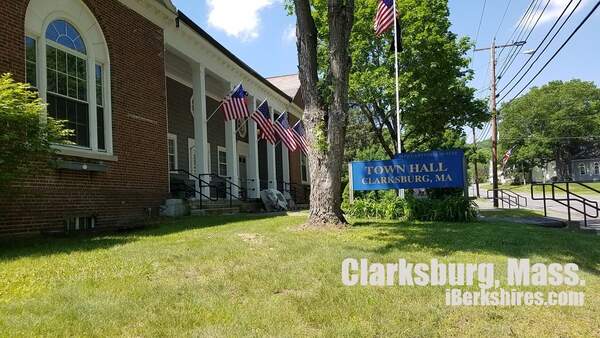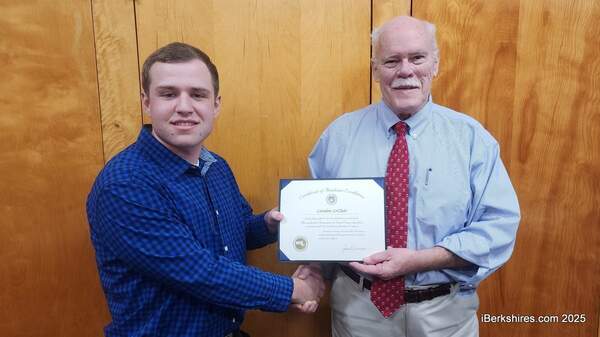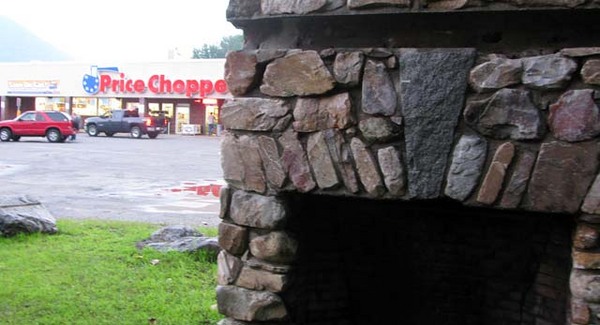
Historical Society Conjures Fort Mass. From Mists of Past
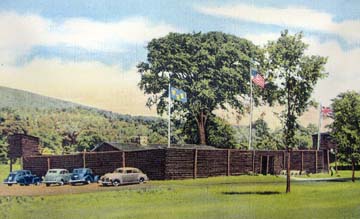 A postcard showing the replica of Fort Massachusetts in the 1940s. The large elm was planted by A.L. Perry around 1860; top, the stone fireplace is all that remains of the reconstructed fort. |
Most residents, if they know of the longgone fort, picture the massive lonely chimney on the edge of the Price Chopper parking lot on State Road. The only indication of what it represents is a large stone nearby engraved in 1976 by the Daughters of the American Revolution to honor the fort's defenders.
"The general public could really care less," said Edward Morandi of the Historical Society. "People who are interested in history ... they know about it."
The city's wilderness past is overshadowed by its more recent history as an important industrial and rail center, in large part because of the Hoosac Tunnel. Trains still run through the 130-year-old portal.
Nothing is left of the wilderness outpost that fell to the French and their Indian allies 263 years ago; or the replacement structure attacked barely two years after. But Fort Massachusetts in 1746 was important link in a chain of frontier forts running across what was then a barely populated region at the far end of the state. Morandi said one report from the fort's soldiers noted how they had "go to New England" to get supplies.
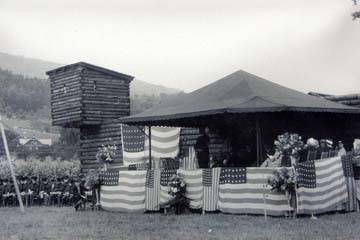 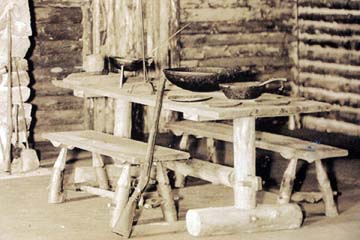 The 1933 dedication of the replica fort and artifacts inside it. Below, Dorothy Ransford reads a poem about an infant born on the captives' march to Canada. The 1933 dedication of the replica fort and artifacts inside it. Below, Dorothy Ransford reads a poem about an infant born on the captives' march to Canada. |
Three forts were constructed in Rowe, Heath and in what at that time was called East Hoosuck. In mid-August 1746, reinforcements from Fort Shirley in Heath arrived at the newly built Fort Massachusetts with the Rev. John Norton, whose tale of capture and captivity would be published in 1748 in Boston.
Barely two dozen soldiers, half sick with "the bloody flux," prepared to defend the log fort from raiding parties. John and Mary Smead fled with their children to the fort; the smoke rising from their burning farm alerted the soldiers. (John Perry, whose log home was also burned, would later petition the General Court for damages to his homestead but apparently was never paid.)
On Aug. 19, some 300 Indians and French troops surrounded Fort Massachusetts. Shots were fired and a soldier in one of the watchtowers killed and several wounded. When the ammunition ran out 28 hours later, the fort surrendered.
"After they had plundered the fort, they set it on fire and led us out to the camp," wrote Norton. Norton and 30 captives in all were marched to Canada.
Captivity Smead was born two nights after the fort fell; she and her mother, Mary, would only make it to Canada with the help of their Indian captors. Mary Smead died seven months later and Captivity in childhood.
The fort was rebuilt the following year and manned during the French and Indian War a decade later. But by the time the American Revolution broke out a generation later, Berkshire County was no longer quite the frontier and a larger fort had been built further west. Fort Massachusetts had been scavenged by local farmers and the site plowed.
Its replica lasted a little longer but not by much. Dedicated on Aug. 21, 1933, by the then Northern Berkshire Historical Society, the reconstructed fort was used as a museum and meeting place. But vandalism and lack of care took their toll. After a short stint as a restaurant, the property was purchased in 1960 by Golub Corp. of New York for a supermarket. All that's left is the stone fireplace from the replica.
No serious archaeological dig was ever made at the site although farmer Clement Harrison and Williams College professor A.L. Perry, who researched the fort in the mid-19th century, turned up a number of artifacts including cannon balls and muskets, probably from the second fort, and discovered footings and the fort's well. Most of those items and others have disappeared or were passed to other institutions over the years after the museum closed. Morandi is doing more research on the topic, particularly straightening out the roles of Ephraim Williams and his relatives in the construction and operation of the frontier forts.
To large extent, the fort's historic significance only exists in the annual observance. So on Sunday, a few people gathered in the barracks room on the third floor of the North Adams Museum of History and Science for a talk by Morandi and readings of Norton's diary by Robert Campanile and the Annie McMillin's 1895 poem "Captivity" by Dorothy Ransford.
Like Gary Lebeau of Pittsfield, who saw a notice on the commemoration in the local paper, they were there because of their deep interest in history.
"I spend time with this every year and maybe, at the most, eight or nine people show up," said Morandi. "What counts is their interest, not their quantity, but their interest."

